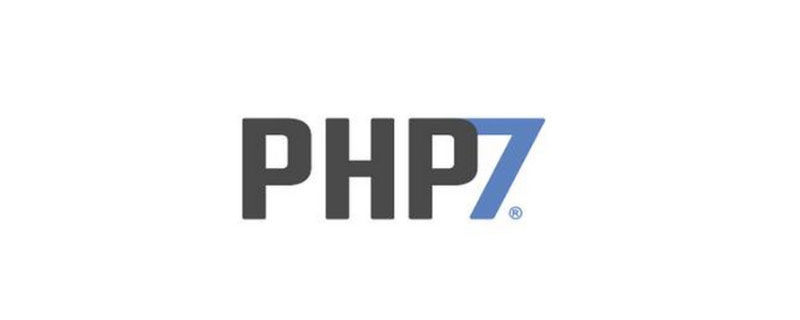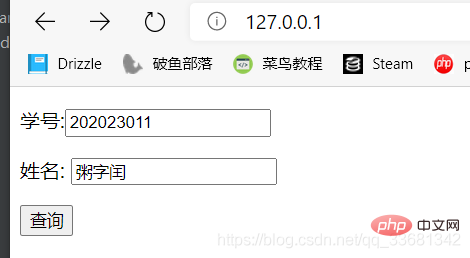How to create a simple query program to connect MySQL with php7
This article will introduce to you how to connect php7 to MySQL to create a simple query program. It has certain reference value. Friends in need can refer to it. I hope it will be helpful to everyone.

Simple Tutorial
Assume that we are making a class status inquiry program and connect the environment using PHP7 in the form of PDO MySQL.
Check your class by student number and name.
Let’s first introduce the file structure and database structure:
PHP:
config.php stores database configuration information
cx. php query program
index.html User interface

The structure is as shown in the figure
MySQL:
Table name: data
Fields: 1.Sid 2.name 3.

Prepare Ready, get started, now!
First build the user interface (index.html), two simple edit boxes plus a simple button:<!DOCTYPE html>
<html>
<head>
<meta charset="UTF-8">
<title>分班查询系统</title>
</head>
<body>
<form action="cx.php" method="post">
<p>学号:<input type="text" name="xuehao"></p>
<p>姓名: <input type="text" name="xingming"></p>
<p><input type="submit" name="submit" value="查询"></p>
</form>
</body>
</html><?php $server="localhost";//主机的IP地址 $db_username="root";//数据库用户名 $db_password="123456";//数据库密码 $db_name = "data";
<?php
header("Content-Type: text/html; charset=utf8");
if(!isset($_POST["submit"]))
{
exit("未检测到表单提交");
}//检测是否有submit操作
include ("config.php");
$Sid = $_POST['Sid'];//post获得学号表单值
$name = $_POST['name'];//post获得姓名表单值
echo "<table style='border: solid 1px black;'>";
echo "<tr><th>学号</th><th>姓名</th><th>班级</th></tr>";
class TableRows extends RecursiveIteratorIterator
{
function __construct($it)
{
parent::__construct($it, self::LEAVES_ONLY);
}
function current()
{
return "<td style='width:150px;border:1px solid black;'>" . parent::current() . "</td>";
}
function beginChildren()
{
echo "<tr>";
}
function endChildren()
{
echo "</tr>" . "\n";
}
}
try {
$conn = new PDO("mysql:host=$server;dbname=$db_name", $db_username, $db_password);
$conn->setAttribute(PDO::ATTR_ERRMODE, PDO::ERRMODE_EXCEPTION);
$stmt = $conn->prepare("SELECT Sid, name, class FROM data where Sid=$Sid and name='$name'");
$stmt->execute();
// 设置结果集为关联数组
$result = $stmt->setFetchMode(PDO::FETCH_ASSOC);
foreach (new TableRows(new RecursiveArrayIterator($stmt->fetchAll())) as $k => $v) {
echo $v;
}
} catch (PDOException $e) {
echo "Error: " . $e->getMessage();
}
$conn = null;
echo "</table>";

The above is the detailed content of How to create a simple query program to connect MySQL with php7. For more information, please follow other related articles on the PHP Chinese website!

Hot AI Tools

Undresser.AI Undress
AI-powered app for creating realistic nude photos

AI Clothes Remover
Online AI tool for removing clothes from photos.

Undress AI Tool
Undress images for free

Clothoff.io
AI clothes remover

Video Face Swap
Swap faces in any video effortlessly with our completely free AI face swap tool!

Hot Article

Hot Tools

Notepad++7.3.1
Easy-to-use and free code editor

SublimeText3 Chinese version
Chinese version, very easy to use

Zend Studio 13.0.1
Powerful PHP integrated development environment

Dreamweaver CS6
Visual web development tools

SublimeText3 Mac version
God-level code editing software (SublimeText3)

Hot Topics
 MySQL's Role: Databases in Web Applications
Apr 17, 2025 am 12:23 AM
MySQL's Role: Databases in Web Applications
Apr 17, 2025 am 12:23 AM
The main role of MySQL in web applications is to store and manage data. 1.MySQL efficiently processes user information, product catalogs, transaction records and other data. 2. Through SQL query, developers can extract information from the database to generate dynamic content. 3.MySQL works based on the client-server model to ensure acceptable query speed.
 How to start mysql by docker
Apr 15, 2025 pm 12:09 PM
How to start mysql by docker
Apr 15, 2025 pm 12:09 PM
The process of starting MySQL in Docker consists of the following steps: Pull the MySQL image to create and start the container, set the root user password, and map the port verification connection Create the database and the user grants all permissions to the database
 Laravel Introduction Example
Apr 18, 2025 pm 12:45 PM
Laravel Introduction Example
Apr 18, 2025 pm 12:45 PM
Laravel is a PHP framework for easy building of web applications. It provides a range of powerful features including: Installation: Install the Laravel CLI globally with Composer and create applications in the project directory. Routing: Define the relationship between the URL and the handler in routes/web.php. View: Create a view in resources/views to render the application's interface. Database Integration: Provides out-of-the-box integration with databases such as MySQL and uses migration to create and modify tables. Model and Controller: The model represents the database entity and the controller processes HTTP requests.
 Solve database connection problem: a practical case of using minii/db library
Apr 18, 2025 am 07:09 AM
Solve database connection problem: a practical case of using minii/db library
Apr 18, 2025 am 07:09 AM
I encountered a tricky problem when developing a small application: the need to quickly integrate a lightweight database operation library. After trying multiple libraries, I found that they either have too much functionality or are not very compatible. Eventually, I found minii/db, a simplified version based on Yii2 that solved my problem perfectly.
 How to install mysql in centos7
Apr 14, 2025 pm 08:30 PM
How to install mysql in centos7
Apr 14, 2025 pm 08:30 PM
The key to installing MySQL elegantly is to add the official MySQL repository. The specific steps are as follows: Download the MySQL official GPG key to prevent phishing attacks. Add MySQL repository file: rpm -Uvh https://dev.mysql.com/get/mysql80-community-release-el7-3.noarch.rpm Update yum repository cache: yum update installation MySQL: yum install mysql-server startup MySQL service: systemctl start mysqld set up booting
 Centos install mysql
Apr 14, 2025 pm 08:09 PM
Centos install mysql
Apr 14, 2025 pm 08:09 PM
Installing MySQL on CentOS involves the following steps: Adding the appropriate MySQL yum source. Execute the yum install mysql-server command to install the MySQL server. Use the mysql_secure_installation command to make security settings, such as setting the root user password. Customize the MySQL configuration file as needed. Tune MySQL parameters and optimize databases for performance.
 Laravel framework installation method
Apr 18, 2025 pm 12:54 PM
Laravel framework installation method
Apr 18, 2025 pm 12:54 PM
Article summary: This article provides detailed step-by-step instructions to guide readers on how to easily install the Laravel framework. Laravel is a powerful PHP framework that speeds up the development process of web applications. This tutorial covers the installation process from system requirements to configuring databases and setting up routing. By following these steps, readers can quickly and efficiently lay a solid foundation for their Laravel project.
 MySQL vs. Other Programming Languages: A Comparison
Apr 19, 2025 am 12:22 AM
MySQL vs. Other Programming Languages: A Comparison
Apr 19, 2025 am 12:22 AM
Compared with other programming languages, MySQL is mainly used to store and manage data, while other languages such as Python, Java, and C are used for logical processing and application development. MySQL is known for its high performance, scalability and cross-platform support, suitable for data management needs, while other languages have advantages in their respective fields such as data analytics, enterprise applications, and system programming.






